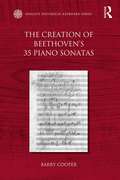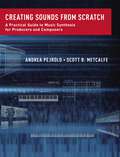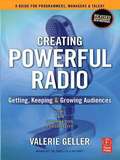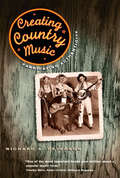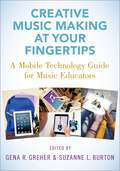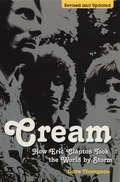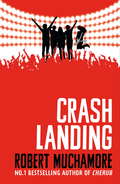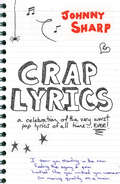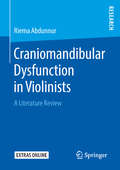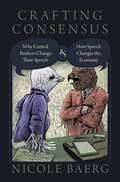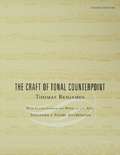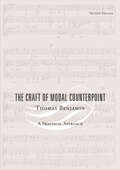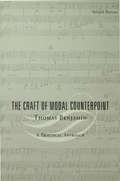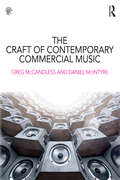- Table View
- List View
The Creation of Beethoven's 35 Piano Sonatas (Ashgate Historical Keyboard Series)
by Barry CooperBeethoven’s piano sonatas are a cornerstone of the piano repertoire and favourites of both the concert hall and recording studio. The sonatas have been the subject of much scholarship, but no single study gives an adequate account of the processes by which these sonatas were composed and published. With source materials such as sketches and correspondence increasingly available, the time is ripe for a close study of the history of these works. Barry Cooper, who in 2007 produced a new edition of all 35 sonatas, including three that are often overlooked, examines each sonata in turn, addressing questions such as: Why were they written? Why did they turn out as they did? How did they come into being and how did they reach their final form? Drawing on the composer’s sketches, autograph scores and early printed editions, as well as contextual material such as correspondence, Cooper explores the links between the notes and symbols found in the musical texts of the sonatas, and the environment that brought them about. The result is a biography not of the composer, but of the works themselves.
The Creation of Beethoven's 35 Piano Sonatas (Ashgate Historical Keyboard Series)
by Barry CooperBeethoven’s piano sonatas are a cornerstone of the piano repertoire and favourites of both the concert hall and recording studio. The sonatas have been the subject of much scholarship, but no single study gives an adequate account of the processes by which these sonatas were composed and published. With source materials such as sketches and correspondence increasingly available, the time is ripe for a close study of the history of these works. Barry Cooper, who in 2007 produced a new edition of all 35 sonatas, including three that are often overlooked, examines each sonata in turn, addressing questions such as: Why were they written? Why did they turn out as they did? How did they come into being and how did they reach their final form? Drawing on the composer’s sketches, autograph scores and early printed editions, as well as contextual material such as correspondence, Cooper explores the links between the notes and symbols found in the musical texts of the sonatas, and the environment that brought them about. The result is a biography not of the composer, but of the works themselves.
CREATING SOUNDS FROM SCRATCH C: A Practical Guide to Music Synthesis for Producers and Composers
by Andrea Pejrolo Scott B. MetcalfeCreating Sounds from Scratch is a practical, in-depth resource on the most common forms of music synthesis. It includes historical context, an overview of concepts in sound and hearing, and practical training examples to help sound designers and electronic music producers effectively manipulate presets and create new sounds. The book covers the all of the main synthesis techniques including analog subtractive, FM, additive, physical modeling, wavetable, sample-based, and granular. While the book is grounded in theory, it relies on practical examples and contemporary production techniques show the reader how to utilize electronic sound design to maximize and improve his or her work. Creating Sounds from Scratch is ideal for all who work in sound creation, composition, editing, and contemporary commercial production.
Creating Sounds from Scratch: A Practical Guide to Music Synthesis for Producers and Composers
by Andrea Pejrolo Scott B. MetcalfeCreating Sounds from Scratch is a practical, in-depth resource on the most common forms of music synthesis. It includes historical context, an overview of concepts in sound and hearing, and practical training examples to help sound designers and electronic music producers effectively manipulate presets and create new sounds. The book covers the all of the main synthesis techniques including analog subtractive, FM, additive, physical modeling, wavetable, sample-based, and granular. While the book is grounded in theory, it relies on practical examples and contemporary production techniques show the reader how to utilize electronic sound design to maximize and improve his or her work. Creating Sounds from Scratch is ideal for all who work in sound creation, composition, editing, and contemporary commercial production.
Creating Powerful Radio: Getting, Keeping and Growing Audiences (PDF)
by Valerie GellerFor Managers, Programmers and Talent * GROW AUDIENCES - Increase your ratings! LifeStage Demographics: Know your audience and how they listen. * PROGRAMMING Build exciting programming - even on dull news days - with proven techniques to guide programmers and talent to the next level of performance. * NEWS: Write, produce and deliver powerful news. Learn multiple version techniques and much more. * PERSONALITY Identify winning talent. Develop strong air personalities. Learn to manage high ego talent and motivate your staff to do their best. * TALK Secrets to improve your show. Learn powerful radio interview techniques and ways to make the talk win big. * INFORMATION Break down the walls between news and entertainment radio. Creative methods to easily write and deliver complex, detailed stories or issues using the multi-version method. * PROMOTIONS Learn methods to spread the word about your station and write powerful copy for more effective promos and commercials. * AIRCHECKING A comprehensive step-by-step guide to show prep and effective airchecking. Valerie Geller is an internationally acclaimed broadcast consultant working with stations that emphasize news, talk, information and personality radio.
Creating Country Music: Fabricating Authenticity
by Richard A. PetersonIn Creating Country Music, Richard Peterson traces the development of country music and its institutionalization from Fiddlin' John Carson's pioneering recordings in Atlanta in 1923 to the posthumous success of Hank Williams. Peterson captures the free-wheeling entrepreneurial spirit of the era, detailing the activities of the key promoters who sculpted the emerging country music scene. More than just a history of the music and its performers, this book is the first to explore what it means to be authentic within popular culture. "[Peterson] restores to the music a sense of fun and diversity and possibility that more naive fans (and performers) miss. Like Buck Owens, Peterson knows there is no greater adventure or challenge than to 'act naturally.'"—Ken Emerson, Los Angeles Times Book Review "A triumphal history and theory of the country music industry between 1920 and 1953."—Robert Crowley, International Journal of Comparative Sociology "One of the most important books ever written about a popular music form."—Timothy White, Billboard Magazine
Creating Country Music: Fabricating Authenticity
by Richard A. PetersonIn Creating Country Music, Richard Peterson traces the development of country music and its institutionalization from Fiddlin' John Carson's pioneering recordings in Atlanta in 1923 to the posthumous success of Hank Williams. Peterson captures the free-wheeling entrepreneurial spirit of the era, detailing the activities of the key promoters who sculpted the emerging country music scene. More than just a history of the music and its performers, this book is the first to explore what it means to be authentic within popular culture. "[Peterson] restores to the music a sense of fun and diversity and possibility that more naive fans (and performers) miss. Like Buck Owens, Peterson knows there is no greater adventure or challenge than to 'act naturally.'"—Ken Emerson, Los Angeles Times Book Review "A triumphal history and theory of the country music industry between 1920 and 1953."—Robert Crowley, International Journal of Comparative Sociology "One of the most important books ever written about a popular music form."—Timothy White, Billboard Magazine
Creating Country Music: Fabricating Authenticity
by Richard A. PetersonIn Creating Country Music, Richard Peterson traces the development of country music and its institutionalization from Fiddlin' John Carson's pioneering recordings in Atlanta in 1923 to the posthumous success of Hank Williams. Peterson captures the free-wheeling entrepreneurial spirit of the era, detailing the activities of the key promoters who sculpted the emerging country music scene. More than just a history of the music and its performers, this book is the first to explore what it means to be authentic within popular culture. "[Peterson] restores to the music a sense of fun and diversity and possibility that more naive fans (and performers) miss. Like Buck Owens, Peterson knows there is no greater adventure or challenge than to 'act naturally.'"—Ken Emerson, Los Angeles Times Book Review "A triumphal history and theory of the country music industry between 1920 and 1953."—Robert Crowley, International Journal of Comparative Sociology "One of the most important books ever written about a popular music form."—Timothy White, Billboard Magazine
Creating Country Music: Fabricating Authenticity
by Richard A. PetersonIn Creating Country Music, Richard Peterson traces the development of country music and its institutionalization from Fiddlin' John Carson's pioneering recordings in Atlanta in 1923 to the posthumous success of Hank Williams. Peterson captures the free-wheeling entrepreneurial spirit of the era, detailing the activities of the key promoters who sculpted the emerging country music scene. More than just a history of the music and its performers, this book is the first to explore what it means to be authentic within popular culture. "[Peterson] restores to the music a sense of fun and diversity and possibility that more naive fans (and performers) miss. Like Buck Owens, Peterson knows there is no greater adventure or challenge than to 'act naturally.'"—Ken Emerson, Los Angeles Times Book Review "A triumphal history and theory of the country music industry between 1920 and 1953."—Robert Crowley, International Journal of Comparative Sociology "One of the most important books ever written about a popular music form."—Timothy White, Billboard Magazine
Creating Country Music: Fabricating Authenticity
by Richard A. PetersonIn Creating Country Music, Richard Peterson traces the development of country music and its institutionalization from Fiddlin' John Carson's pioneering recordings in Atlanta in 1923 to the posthumous success of Hank Williams. Peterson captures the free-wheeling entrepreneurial spirit of the era, detailing the activities of the key promoters who sculpted the emerging country music scene. More than just a history of the music and its performers, this book is the first to explore what it means to be authentic within popular culture. "[Peterson] restores to the music a sense of fun and diversity and possibility that more naive fans (and performers) miss. Like Buck Owens, Peterson knows there is no greater adventure or challenge than to 'act naturally.'"—Ken Emerson, Los Angeles Times Book Review "A triumphal history and theory of the country music industry between 1920 and 1953."—Robert Crowley, International Journal of Comparative Sociology "One of the most important books ever written about a popular music form."—Timothy White, Billboard Magazine
Creating Country Music: Fabricating Authenticity
by Richard A. PetersonIn Creating Country Music, Richard Peterson traces the development of country music and its institutionalization from Fiddlin' John Carson's pioneering recordings in Atlanta in 1923 to the posthumous success of Hank Williams. Peterson captures the free-wheeling entrepreneurial spirit of the era, detailing the activities of the key promoters who sculpted the emerging country music scene. More than just a history of the music and its performers, this book is the first to explore what it means to be authentic within popular culture. "[Peterson] restores to the music a sense of fun and diversity and possibility that more naive fans (and performers) miss. Like Buck Owens, Peterson knows there is no greater adventure or challenge than to 'act naturally.'"—Ken Emerson, Los Angeles Times Book Review "A triumphal history and theory of the country music industry between 1920 and 1953."—Robert Crowley, International Journal of Comparative Sociology "One of the most important books ever written about a popular music form."—Timothy White, Billboard Magazine
CREAT MUSIC MAKING AT YOUR FINGERTIPS C: A Mobile Technology Guide for Music Educators
by Gena R. Greher, Suzanne L. BurtonStudents are drawn to mobile technologies such as iPads and smartphones because of the sheer endless possibilities of the digital worlds they hold. But how can their potential for stimulating the imagination be effectively used in the music classroom to support students' development of musical thinking? Countering voices that see digital technologies as a threat to traditional forms of music making and music education, this collection explores the many ways in which hand-held devices can be used to promote student learning and provides teachers with guidance on making them a vital presence in their own classrooms. Creative Music Making at Your Fingertips features 11 chapters by music education scholars and practitioners that provide tried-and-true strategies for using mobile devices in a variety of contexts, from general music education to ensembles and from K-12 to college classrooms. Drawing on their own experiences with bringing mobile devices and different music apps into the classroom, contributors show how these technologies can be turned into tools for teaching performance, improvisation, and composition. Their practical advice on how pedagogy and mobile technologies can be aligned to increase students' creative engagement with music and help them realize their musical potential makes this book an invaluable resource for music educators who want to be at the forefront of pedagogical transformations made possible by 21st-century technologies.
Cream: How Eric Clapton Took The World By Storm
by Dave ThompsonDave Thompson, author of Virgin's acclaimed Red Hot Chili Peppers biography, takes a new and very detailed look at the creation of one of the world's most influential bands. After all the streets of London had been covered in 'Clapton Is God' tributes, the three top rock instrumentalists of their time, all stars in their own right, came together to form Cream. Cream went on to become the first band to break openthe lucrative US market by dint of their live shows alone. Updated to include details of their recent tour, this definitive account goes on the road with them then and now, day by relentlessly hedonistic day.
Crash Landing: Book 4 (Rock War)
by Robert MuchamoreDon't miss the last episode of international bestseller Robert Muchamore's ROCK WAR series! Jay, Summer and Dylan are fresh out of the biggest reality show there is. But they're about to discover what fame and fortune are really about. Jay's brother Theo is young, rich and famous: but is it making him happy?Summer's got to weather her one-star reviews and take her career back into her own hands.And Dylan might soon be seeing the world of show-business from the four walls of a prison cell. They've got everything to play for. From the author of CHERUB and Henderson's Boys: find out more at rockwar.com
Crap Lyrics: A Celebration Of The Very Worst Pop Lyrics Of All Time... Ever!
by Johnny SharpEven the greatest songwriters (and Spandau Ballet) have had the odd bad day at the office. Or more likely, a bad few minutes in the studio toilets scribbling the first words they can think of on the back of their tranquiliser prescription shortly before the vocal has to be recorded.
Craniomandibular Dysfunction in Violinists: A Literature Review
by Riema AbdunnurRiema Abdunnur gives insight into publications focusing on performing violinists, particularly on those suffering from CMD, subsequently providing a better understanding to the unique work conditions of violinists, and enhancing diagnosis and therapeutic results by practitioner dentists. Moreover, the analysis of the included papers aims to reveal what exactly was studied in violinists regarding to CMD, and how far manual medicine was included there. The conclusion of the author is, playing violin could be classified as a potential factor associated with CMD in violinists. More researches that take the interdisciplinary collaboration between dental and manual medicine into special account are recommended.About the Author Riema Abdunnur did her research studies at Medical University of Innsbruck, Austria.
Crafting Consensus: Why Central Bankers Change Their Speech and How Speech Changes the Economy
by Nicole BaergIn a world dependent on the constant sharing of information, central bankers increasingly communicate their policies to the mass public. Central bank communications are drafted in monetary policy committee meetings composed of policymakers with differing interests. Despite their differences, committee members must come together, write, and agree to an official policy statement. Once released to the public, central bank communications then affect citizens' actions and ultimately, the economy. But how exactly does this work? In Crafting Consensus, Nicole Baerg explains how the transparency of central bank communication depends on the configuration of committee members' preferences. Baerg argues that monetary policy committees composed of members with differing preferences over inflation are better suited to communicating precise information with the public. These diverse committees produce central bank statements of higher quality and less uncertainty than those from more homogeneous committees. Additionally, she argues that higher quality statements more effectively shape individuals' inflation expectations and move the economy in ways that policymakers intend. Baerg demonstrates that central bankers are not impartial technocrats and that their preferences and the institutional rules where they work matter for understanding the politics of monetary policy and variations in economic performance over time. Conducting empirical analysis from historical archival data, textual analysis, machine-learning, survey experiments, and cross-sectional time-series data, Crafting Consensus offers a new theory of committee decision making and a battery of empirical tests to provide a rich understanding of modern-day central banking.
Crafting Consensus: Why Central Bankers Change Their Speech and How Speech Changes the Economy
by Nicole BaergIn a world dependent on the constant sharing of information, central bankers increasingly communicate their policies to the mass public. Central bank communications are drafted in monetary policy committee meetings composed of policymakers with differing interests. Despite their differences, committee members must come together, write, and agree to an official policy statement. Once released to the public, central bank communications then affect citizens' actions and ultimately, the economy. But how exactly does this work? In Crafting Consensus, Nicole Baerg explains how the transparency of central bank communication depends on the configuration of committee members' preferences. Baerg argues that monetary policy committees composed of members with differing preferences over inflation are better suited to communicating precise information with the public. These diverse committees produce central bank statements of higher quality and less uncertainty than those from more homogeneous committees. Additionally, she argues that higher quality statements more effectively shape individuals' inflation expectations and move the economy in ways that policymakers intend. Baerg demonstrates that central bankers are not impartial technocrats and that their preferences and the institutional rules where they work matter for understanding the politics of monetary policy and variations in economic performance over time. Conducting empirical analysis from historical archival data, textual analysis, machine-learning, survey experiments, and cross-sectional time-series data, Crafting Consensus offers a new theory of committee decision making and a battery of empirical tests to provide a rich understanding of modern-day central banking.
The Craft of Tonal Counterpoint
by Thomas BenjaminFirst Published in 2003. Routledge is an imprint of Taylor & Francis, an informa company.
The Craft of Tonal Counterpoint
by Thomas BenjaminFirst Published in 2003. Routledge is an imprint of Taylor & Francis, an informa company.
Craft Of Modal Counterpoint (PDF)
by Thomas Benjamin"The Craft of Modal Counterpoint" is the companion book to Benjamin's "The Craft of Tonal Counterpoint," recently republished in a second edition by Routledge. Modal counterpoint is the style of composition that was employed until the "tonal" revolution pioneered by Bach; it is the basis for most Early Music. Benjamin, a composer and pedagogue, offers a complete analysis of this important musical style. He begins by covering general aspects of the style, then covers in detail two, three, and four-part counterpoint. The Motet, an important form of vocal composition in this period, is studied separately. The book concludes with a brief anthology of key scores, 15 in all, for the student to study further. Also includes 132 musical examples.
The Craft of Modal Counterpoint: A Practical Approach
by Thomas Benjamin"The Craft of Modal Counterpoint" is the companion book to Benjamin's "The Craft of Tonal Counterpoint," recently republished in a second edition by Routledge. Modal counterpoint is the style of composition that was employed until the "tonal" revolution pioneered by Bach; it is the basis for most Early Music. Benjamin, a composer and pedagogue, offers a complete analysis of this important musical style. He begins by covering general aspects of the style, then covers in detail two, three, and four-part counterpoint. The Motet, an important form of vocal composition in this period, is studied separately. The book concludes with a brief anthology of key scores, 15 in all, for the student to study further. Also includes 132 musical examples.
The Craft of Modal Counterpoint
by Thomas Benjamin"The Craft of Modal Counterpoint" is the companion book to Benjamin's "The Craft of Tonal Counterpoint," recently republished in a second edition by Routledge. Modal counterpoint is the style of composition that was employed until the "tonal" revolution pioneered by Bach; it is the basis for most Early Music. Benjamin, a composer and pedagogue, offers a complete analysis of this important musical style. He begins by covering general aspects of the style, then covers in detail two, three, and four-part counterpoint. The Motet, an important form of vocal composition in this period, is studied separately. The book concludes with a brief anthology of key scores, 15 in all, for the student to study further. Also includes 132 musical examples.
The Craft of Contemporary Commercial Music
by Greg McCandless Daniel McIntyreIn the contemporary world, the role of the commercial composer has grown to include a wide range of new responsibilities. Modern composers not only write music, but also often need to perform, record, and market their own works. The Craft of Contemporary Commercial Music prepares today’s music students for their careers by teaching them to compose their own music, produce it professionally, and sell it successfully. The textbook integrates three areas of concentration—music theory and composition, audio engineering, and music business—allowing students to understand and practice how to successfully navigate each stage of a score’s life cycle from concept to contract. Students will learn how to: Translate musical ideas into scores utilizing music theory and composition techniques Transform scores into professional audio through the production stages of tracking, sequencing, editing, mixing, mastering, and bouncing Market works to prospective clients The textbook assumes no prior knowledge of music theory or audio topics, and its modular organization allows instructors to use the book flexibly. Exercises at the end of each chapter provide practice with key skills, and a companion website supports the book with video walkthroughs, streaming audio, a glossary, and printable exercise pages. Combining a grounding in music notation and theory concepts with a foundation in essential technologies, The Craft of Contemporary Commercial Music offers an innovative approach that addresses the needs of students preparing for music careers.
The Craft of Contemporary Commercial Music
by Greg McCandless Daniel McIntyreIn the contemporary world, the role of the commercial composer has grown to include a wide range of new responsibilities. Modern composers not only write music, but also often need to perform, record, and market their own works. The Craft of Contemporary Commercial Music prepares today’s music students for their careers by teaching them to compose their own music, produce it professionally, and sell it successfully. The textbook integrates three areas of concentration—music theory and composition, audio engineering, and music business—allowing students to understand and practice how to successfully navigate each stage of a score’s life cycle from concept to contract. Students will learn how to: Translate musical ideas into scores utilizing music theory and composition techniques Transform scores into professional audio through the production stages of tracking, sequencing, editing, mixing, mastering, and bouncing Market works to prospective clients The textbook assumes no prior knowledge of music theory or audio topics, and its modular organization allows instructors to use the book flexibly. Exercises at the end of each chapter provide practice with key skills, and a companion website supports the book with video walkthroughs, streaming audio, a glossary, and printable exercise pages. Combining a grounding in music notation and theory concepts with a foundation in essential technologies, The Craft of Contemporary Commercial Music offers an innovative approach that addresses the needs of students preparing for music careers.
